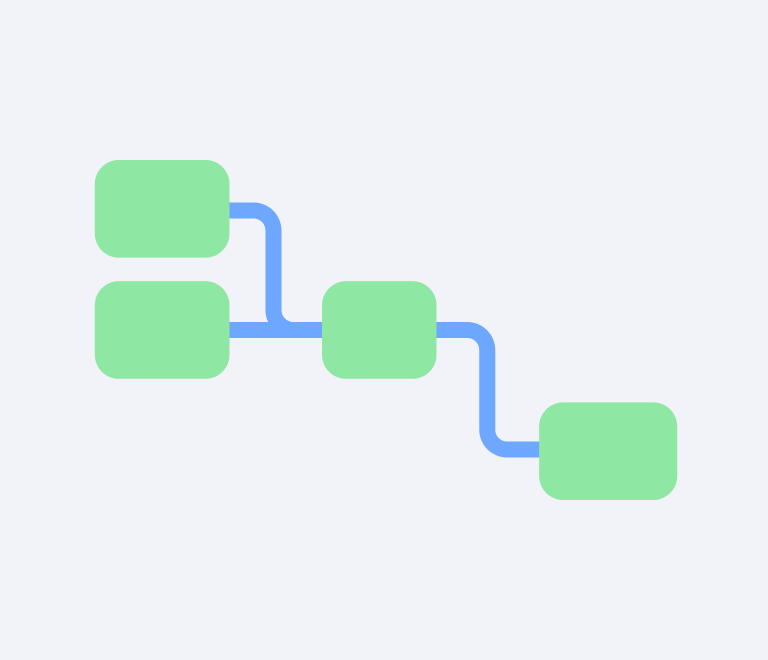What is a Gantt Chart? Definition, Benefits, Examples & Templates
Project Roadmap: How To Build This And How To Use Properly
Having a clear sense of direction is crucial for success, whether you're managing a project, steering a business, or planning your personal career path. This is where roadmaps come into play. But what exactly is a roadmap, and why is it so essential?
In this article, we'll delve into the concept of roadmaps, exploring their various types, how to create them, and why they are indispensable in different contexts.
What is a Roadmap?
A roadmap is a strategic planning tool that visually represents the key steps and milestones needed to achieve specific goals over a defined period. It serves as a high-level guide that outlines the objectives, timelines, and critical milestones for a project, business initiative, or personal plan.
Unlike a detailed project plan, a roadmap provides a broad overview, highlighting the major phases and deliverables without getting bogged down in granular details.
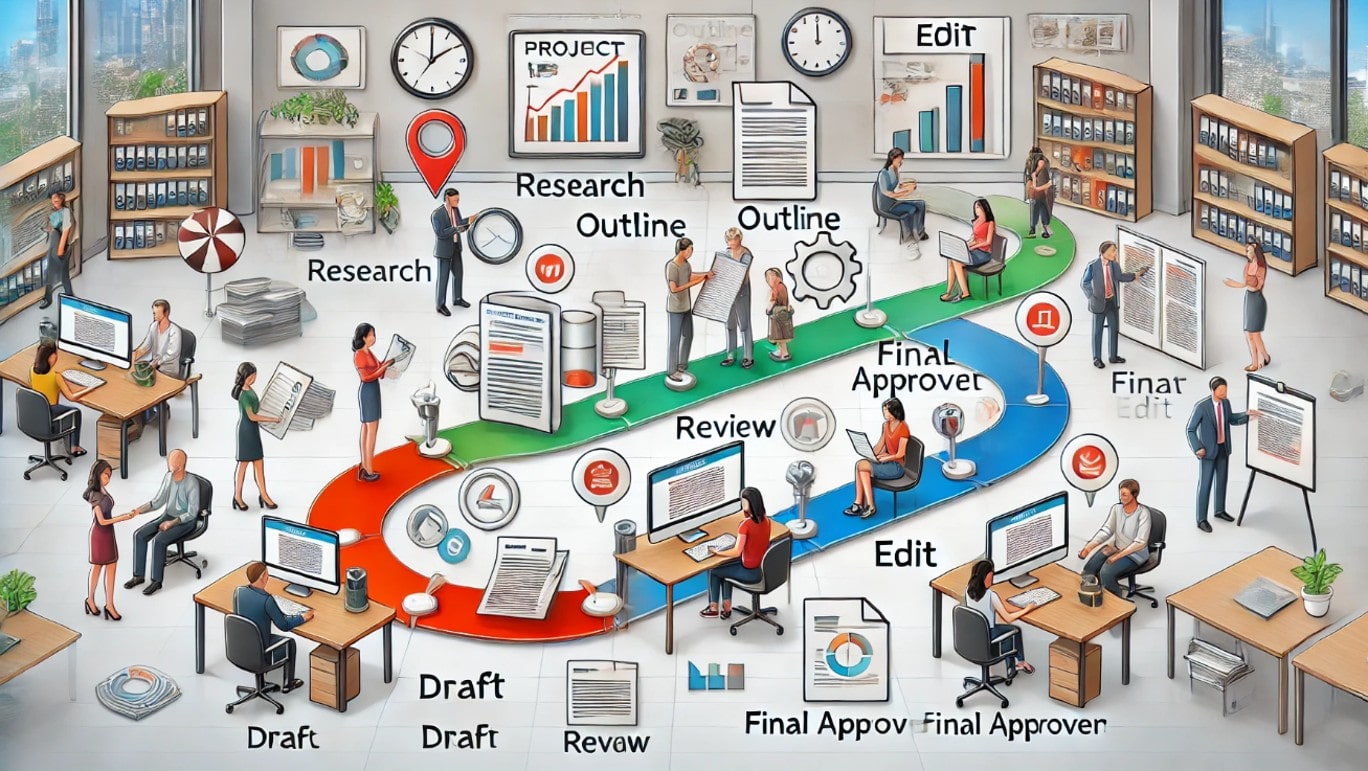
Key Components of a Roadmap
- Goals and Objectives: clearly defined targets that the roadmap aims to achieve.
- Milestones: significant checkpoints or achievements along the way.
- Timelines: timeframes for reaching each milestone and the overall goal.
- Tasks and Activities: major tasks and activities required to reach the milestones.
- Responsibility: assignment of tasks to specific team members or stakeholders.
How to Develop a Product Roadmap
 Creating a product roadmap involves several key steps that ensure it effectively guides the development and launch of a product. Here’s a step-by-step guide to creating a product roadmap:
Creating a product roadmap involves several key steps that ensure it effectively guides the development and launch of a product. Here’s a step-by-step guide to creating a product roadmap:
1.Define Objectives and Goals
- Identify the Product Vision: clearly articulate the long-term vision for the product. This vision should align with the overall business strategy and address the needs of the target market.
- Set Specific Goals: determine what you want to achieve with the product. Goals could include market penetration, revenue targets, user engagement metrics, or customer satisfaction levels.
2. Gather Requirements and Inputs
- Stakeholder Input: engage with key stakeholders, including customers, sales teams, and executives, to gather insights and requirements. Understanding their perspectives ensures the roadmap addresses all critical aspects.
- Market Research: conduct thorough market research to understand industry trends, customer needs, and competitive landscape. This information helps in setting realistic and market-driven goals.
3. Identify Key Milestones
- Major Phases: break down the product development process into major phases, such as ideation, prototyping, testing, and launch.
- Critical Milestones: identify significant milestones within each phase. These could include prototype completion, beta testing, market validation, and product launch.
4. Set Timelines
- Define Timeframes: establish realistic timeframes for each phase and milestone. Consider factors such as development complexity, resource availability, and external dependencies.
- Create a Timeline: visualize the timeline in the roadmap, showing the sequence of phases and milestones. Ensure that the timeline is flexible enough to accommodate changes.
5. Assign Responsibilities
- Team Assignments: allocate tasks and responsibilities to specific team members or departments. Clearly define who is accountable for each milestone and deliverable.
- Resource Planning: ensure that resources, including personnel, budget, and tools, are adequately planned and allocated for each phase of the product development.
Types of Roadmaps
Roadmaps come in various forms, each tailored to meet specific needs and contexts. Understanding the different types of roadmaps can help you choose the right one for your goals. Here are some of the most common types:
1. Project Roadmaps
Project roadmaps provide a high-level overview of a project’s objectives, milestones, and deliverables. They help project managers and teams stay on track by outlining the major phases of the project, expected timelines, and key milestones.
Example of How to Create a Project Roadmap

Project roadmap built in Planyway
Project: Launching a New Website
Goals: Launch a new website to improve user engagement and increase sales.
Objectives:
- Design a user-friendly interface.
- Develop and test the website.
- Launch the website by the end of Q3.
Key Deliverables:
- User Research Report
- Wireframes and Mockups
- Functional Prototype
- Tested Website
Milestones:
- Research Completion: June 15
- Design Finalization: July 15
- Development Completion: August 15
- Testing Completion: September 1
- Launch: September 30
Milestones and Timeline:
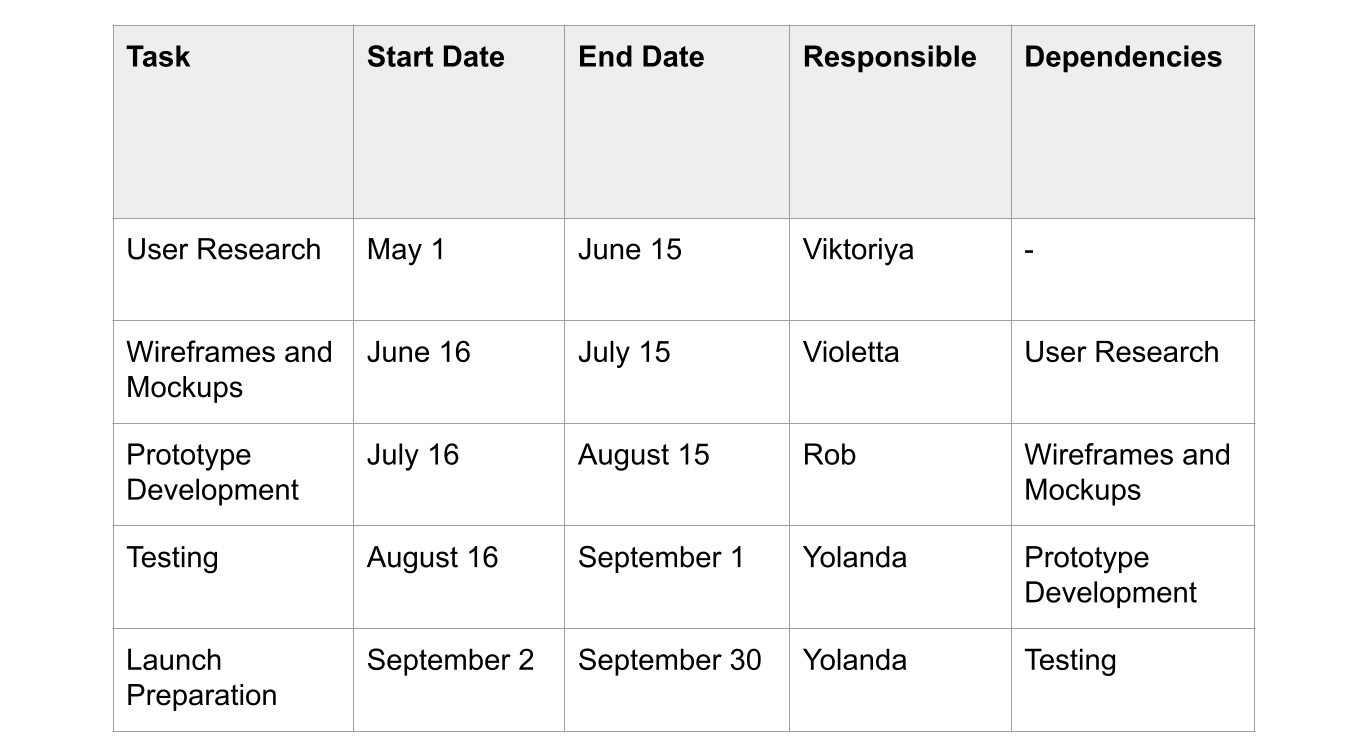
Resources:
- Budget: $50,000
- Personnel: 5 team members
- Equipment: laptops, testing servers
- Risk: delays in design approval
- Mitigation: set up regular review meetings with stakeholders.
- Risk: technical issues during development
- Mitigation: allocate extra time for unexpected issues and have backup plans.
2. Product Roadmaps
Product roadmaps provide a strategic overview of a product's vision, direction, priorities, and progress. They communicate the why and what behind what you're building. They align the product team around specific goals and ensure that everyone understands the plan.
Example of a Product Roadmap

Product roadmap built in Planyway
Product: Mobile App for Personal Finance Management
Vision: Empower users to manage their personal finances effectively and achieve financial well-being.
Goals:
- Increase user engagement.
- Enhance user experience.
- Expand user base.
Objectives:
- Add new budgeting features.
- Improve app performance.
- Launch a marketing campaign.
Key Features and Initiatives:
- Budgeting Tools: allow users to set and track budgets.
- Performance Improvements: optimize the app for faster loading times.
- Marketing Campaign: increase awareness and acquire new users.
Milestones and Timeline:
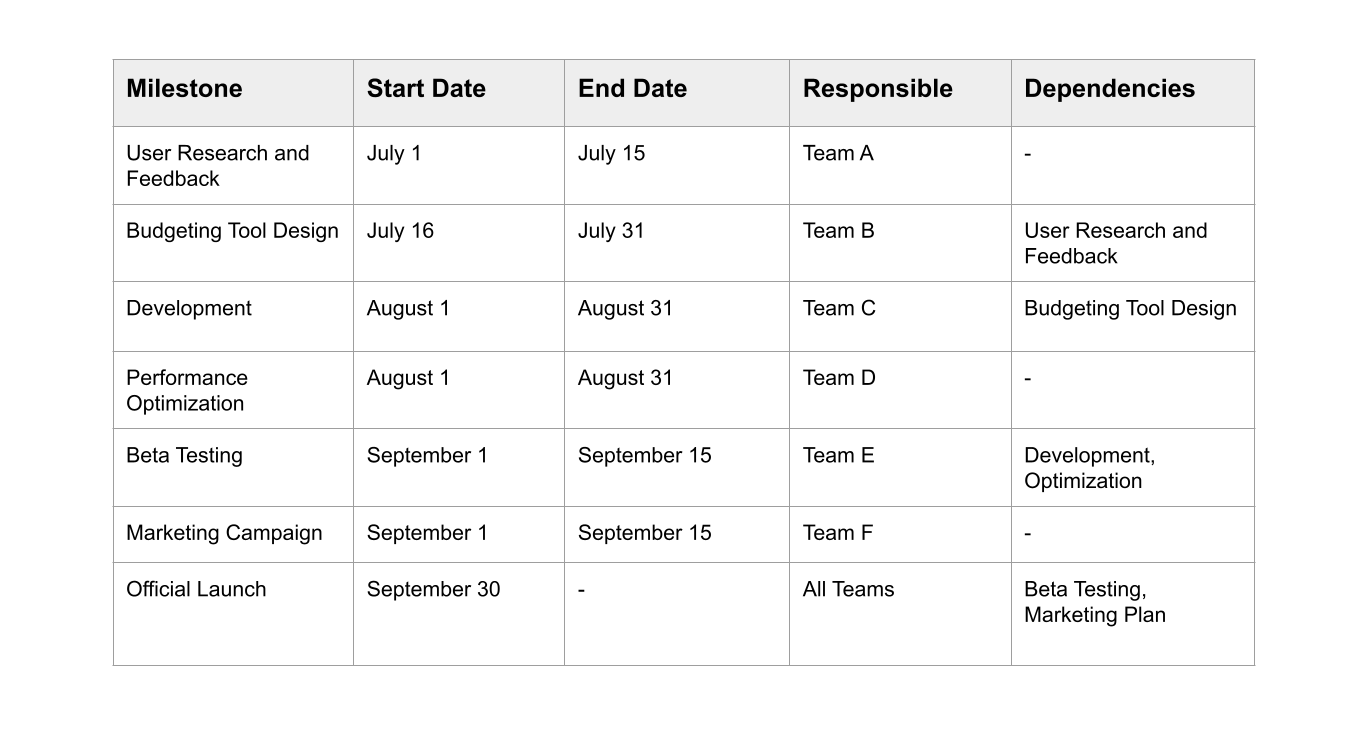 Resources:
Resources:
- Budget: $100,000
- Personnel: 6 team members
- Tools: user research tools, development software, marketing platforms
Risk Management:
- Risk: delays in development
- Mitigation: implement regular check-ins and agile methodologies.
- Risk: negative user feedback during beta testing
- Mitigation: allocate time for addressing feedback and making necessary adjustments.
3. Business Roadmaps
Business roadmaps focus on the strategic direction of a company. They align various departments and stakeholders by providing a clear vision of the company’s goals and the steps needed to achieve them.
Example Scenarios:
- Strategic Planning: setting long-term business goals and identifying the steps to reach them.
- Market Expansion: planning the entry into new markets, including timelines and key actions.
4. Technology Roadmaps
Technology roadmaps outline the development and implementation of technological solutions within an organization. They ensure that IT initiatives align with business goals and help in prioritizing tech investments.
Example Scenarios:
- IT Infrastructure: planning upgrades and maintenance of IT systems.
- Software Development: scheduling development phases and releases for new software products.
4. Value Roadmaps
Value roadmaps focus on delivering value to customers and stakeholders. They outline how the organization plans to enhance value through various initiatives, ensuring that every action taken aligns with the goal of maximizing value.
What are the Components of a Typical Value Roadmap:
- Vision and Mission: a future-oriented declaration of the organization's purpose and aspirations and the core purpose and focus of the organization that remains unchanged over time.
- Strategic Objectives: clear, long-term goals that align with the vision and mission. These objectives guide the overall direction of the organization.
- Initiatives and Projects: specific programs, projects, or activities designed to achieve the strategic objectives. Each initiative should have a clear scope, timeline, and set of deliverables.
- Milestones and Timelines: key dates and events that mark significant progress points within initiatives and projects. These help track progress and ensure timely delivery of value.
- Key Performance Indicators (KPIs): metrics used to measure the success of initiatives and projects. KPIs should be aligned with strategic objectives and provide quantifiable evidence of progress.
- Value Propositions: statements that summarize the benefits delivered by the organization to its customers, stakeholders, or beneficiaries. These should highlight what makes the organization’s offerings unique and valuable.
- Stakeholder Analysis: identification and analysis of individuals or groups who have an interest in the organization’s activities. Understanding stakeholder needs and expectations is crucial for delivering value.
- Resource Allocation: overview of the resources (e.g., financial, human, technological) required to execute initiatives and projects. Effective resource management ensures that initiatives are feasible and sustainable.
- Risk Management: identification and mitigation of potential risks that could impact the successful execution of the roadmap. This includes contingency plans for addressing unforeseen challenges.
- Communication Plan: strategy for keeping stakeholders informed and engaged throughout the implementation of the roadmap. This ensures transparency and fosters collaboration.
- Feedback and Iteration: mechanisms for gathering feedback and making iterative improvements to the roadmap. This helps adapt to changing circumstances and continuously enhance value delivery.
Example Scenarios:
- Customer Experience Improvement: identifying and implementing changes to enhance customer satisfaction.
- Product Value Enhancement: planning updates and features that increase the overall value of the product.
5. Marketing Roadmaps
Marketing roadmaps outline the strategic marketing initiatives and campaigns over a specified period. They help marketing teams plan and execute campaigns effectively, ensuring alignment with business goals.
Example of a Marketing Roadmap
Goal: Increase Brand Awareness and Generate Leads
Objectives:
- Increase website traffic by 30% in the next six months.
- Generate 1,000 new leads per month.
- Improve social media engagement by 50%.
Key Marketing Initiatives:
- Content Marketing: blog posts, whitepapers, case studies.
- Social Media Campaigns: Facebook, Instagram, LinkedIn.
- Email Marketing: monthly newsletters, drip campaigns.
- PPC Advertising: Google Ads, Facebook Ads.
Milestones and Timeline:
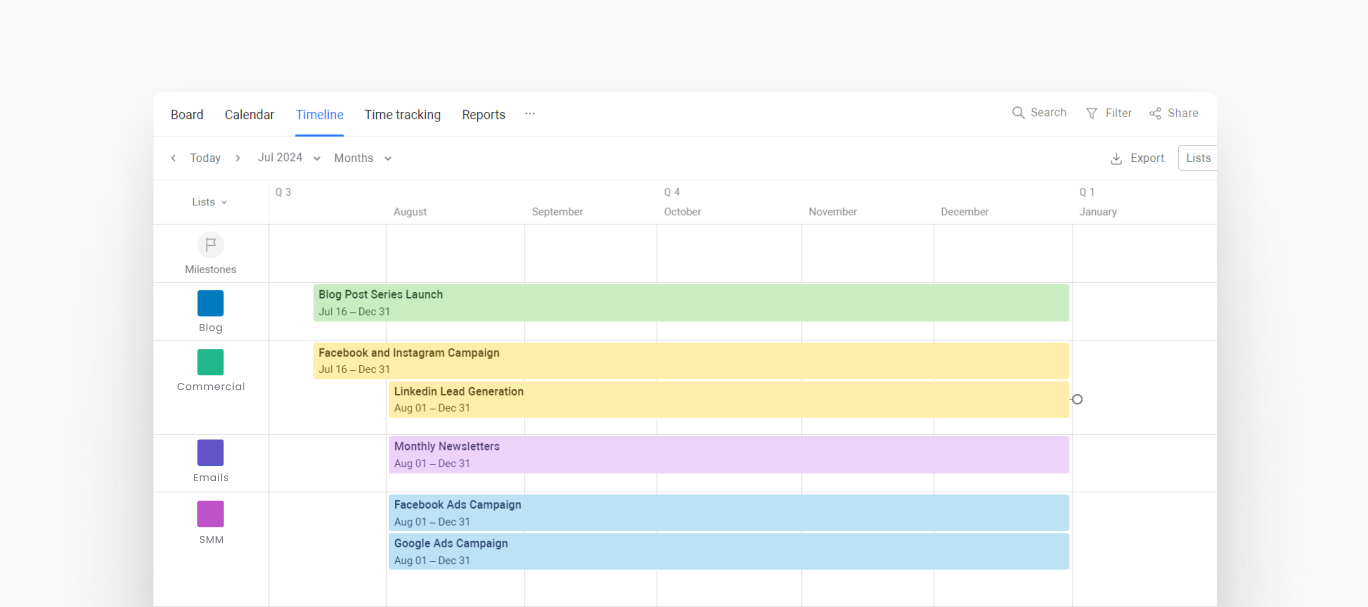
Marketing roadmap built in Planyway
Resources:
- Budget: $200,000
- Personnel: Content Team, Social Media Team, Email Marketing Team, PPC Team
- Tools: SEO tools, social media management tools, email marketing software, PPC platforms
KPIs:
- Website Traffic: Google Analytics data.
- Lead Generation: CRM data.
- Social Media Engagement: likes, shares, comments, followers.
- Email Open and Click-Through Rates: email marketing software data.
- PPC Metrics: CTR, conversion rates, cost per lead.
Risk Management:
- Risk: low engagement on social media campaigns.
- Mitigation: conduct A/B testing to identify effective content and formats.
- Risk: high cost per lead in PPC campaigns.
- Mitigation: continuously optimize campaigns and adjust targeting strategies.
7. DMAIC Roadmap
The DMAIC roadmap is a structured, data-driven methodology used in Six Sigma for process improvement. DMAIC stands for Define, Measure, Analyze, Improve, and Control. Each phase serves a specific purpose in guiding teams through the process of identifying and implementing improvements to achieve high-quality outcomes.
- Define: this initial phase involves clearly defining the problem, project goals, and customer (both internal and external) requirements. During this stage, teams identify key stakeholders and create a project charter outlining the scope, objectives, and resources needed. Tools like SIPOC (Suppliers, Inputs, Process, Outputs, and Customers) diagrams are often used to map out the process and understand the high-level flow of activities.
- Measure: in the Measure phase, the current performance of the process is quantified. This involves collecting data to establish a baseline and identifying key performance indicators (KPIs). The goal is to measure the extent of the problem and ensure that the metrics used are reliable and valid. This phase often involves the use of statistical tools to ensure data accuracy.
- Analyze: during the Analyze phase, the root causes of process inefficiencies and defects are identified. The team uses data collected in the Measure phase to perform detailed analysis and pinpoint where and why problems occur. Techniques such as cause-and-effect diagrams, regression analysis, and hypothesis testing are commonly used.
- Improve: in the Improve phase, solutions to address the root causes identified in the Analyze phase are developed and implemented. The focus is on generating, evaluating, and selecting the best solutions to improve process performance. This may involve redesigning processes, optimizing workflows, or implementing new technologies. Pilot tests are often conducted to validate the effectiveness of proposed improvements.
- Control: the final phase, Control, ensures that the improvements are sustained over time. This involves implementing control mechanisms such as standard operating procedures (SOPs), control charts, and continuous monitoring systems. The objective is to maintain the gains achieved and ensure that the process remains stable and consistent.
8. Strategic Roadmap
A strategic roadmap is a visual or conceptual representation of the steps and milestones necessary to achieve long-term goals and objectives outlined in a strategic plan. It provides a clear path from the current state to the desired future state, highlighting key actions, timelines, and responsibilities. Creating a roadmap for a strategic plan involves several steps:
How to Create a Roadmap for a Strategic Plan
- Define the Vision and Goals: clearly articulate the long-term vision of the organization. Break down the vision into specific, measurable, achievable, relevant, and time-bound (SMART) goals.
- Conduct a SWOT Analysis: identify the organization’s strengths, weaknesses, opportunities, and threats to understand the internal and external factors affecting the strategic plan.
- Identify Key Initiatives: determine the major projects or initiatives that need to be undertaken to achieve the strategic goals. Prioritize them based on their impact and feasibility.
- Define Milestones and Deliverables: break down each initiative into smaller, manageable milestones and define the deliverables for each milestone.
- Develop a Timeline: create a timeline for each initiative, specifying the start and end dates, and key milestones. Ensure that the timeline is realistic and achievable.
- Assign Responsibilities: assign specific tasks and responsibilities to team members or departments. Clearly define who is responsible for what and by when.
- Allocate Resources: Determine the resources (financial, human, technological, etc.) needed to execute the initiatives and ensure they are available.
- Create Visual Representation: use a visual tool (like Gantt charts, Kanban boards, or specialized roadmap software like Planyway) to create a clear and concise visual representation of the strategic roadmap.
- Communicate the Roadmap: share the roadmap with all stakeholders to ensure alignment and understanding. This can be done through presentations, meetings, and written documentation.
- Monitor and Adjust: continuously monitor progress against the roadmap, track key performance indicators (KPIs), and be prepared to make adjustments as necessary to stay on course.
Tools for Creating Roadmaps
There are multiple tools available to help product managers and teams create effective and visually appealing roadmaps. Let’s explore some of the most popular, highlighting their key features and benefits.
Planyway: Calendar and Timeline Views for Enhanced Planning
Planyway is a versatile tool that offers calendar and timeline views, making it easy to plan and visualize project roadmaps from different angles.

Key features include:
- Calendar and Timeline Views: switch between calendar and timeline views to suit your planning needs.
- Portfolio Roadmap: get a high-level view of all projects and initiatives within an organization. It helps in aligning these projects with the overall business strategy and in prioritizing resource allocation.
- Integrations: use Planyway as a Trello Power-Up or Jira extension.
- Resource Management: allocate resources and track workload across projects.
- Collaboration Features: collaborate with team members and share plans easily.
Planyway is ideal for teams that need detailed scheduling and resource management capabilities in addition to roadmap planning. Plus, the app includes time tracking functionality.
Aha!: A Comprehensive Roadmap Planning Tool
Aha! is a robust tool designed for product managers who need a comprehensive solution for planning and managing product roadmaps.
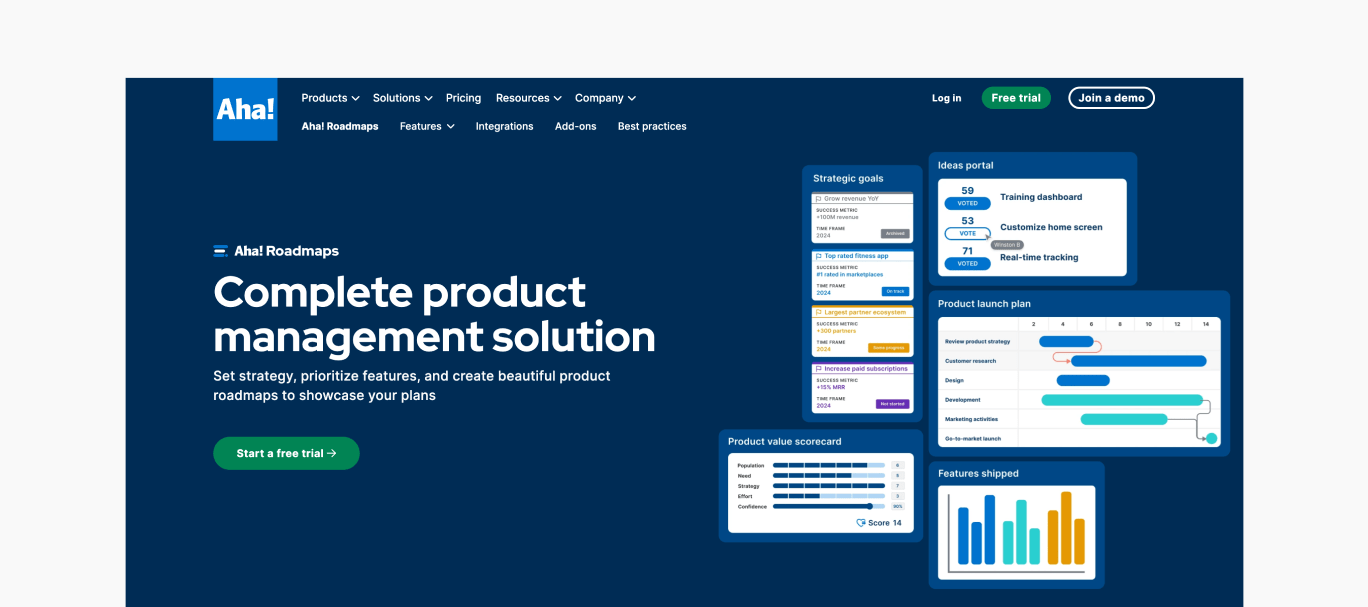
It offers a wide range of features, including:
- Strategy Roadmaps: align product goals with business objectives.
- Release Planning: organize releases and track progress.
- Idea Management: collect and prioritize feedback from customers and stakeholders.
- Integration Capabilities: integrate with tools like Jira, Slack, and GitHub.
Aha! is particularly well-suited for organizations that require a detailed and strategic approach to roadmap planning.
ProductPlan: Easy-to-Use with Drag-and-Drop Features
ProductPlan is known for its intuitive interface and ease of use. It allows product managers to create and share beautiful roadmaps using a simple drag-and-drop interface.

Key features include:
- Visual Roadmaps: create clear and compelling visual roadmaps.
- Collaboration Tools: share roadmaps with teams and stakeholders for real-time collaboration.
- Custom Views: tailor roadmap views to meet different audience needs.
- Integration Options: connect with tools like Jira, Slack, and Trello.
ProductPlan is ideal for teams looking for a straightforward tool that prioritizes visual clarity and ease of use.
Roadmunk: Offers Various Templates and Collaboration Features
Roadmunk provides a range of templates and collaboration features that make it easy to create and manage product roadmaps.
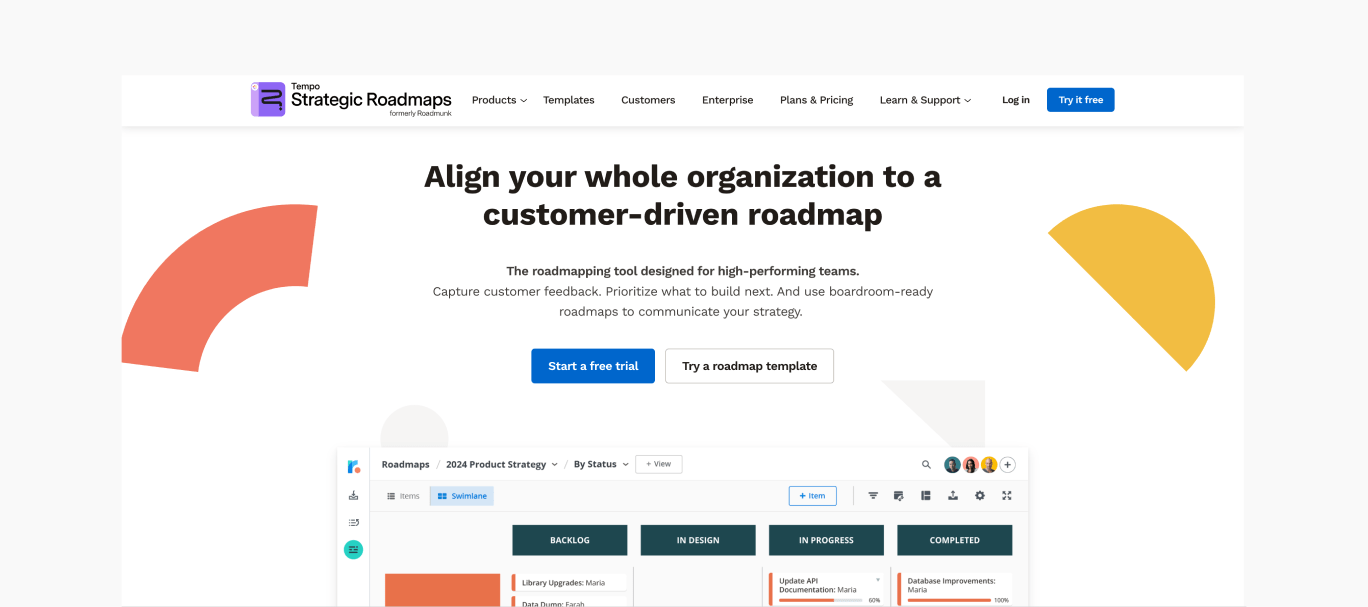
Its notable features include:
- Customizable Templates: choose from a variety of templates to get started quickly.
- Collaboration Tools: enable team collaboration and feedback directly within the platform.
- Timeline and Swimlane Views: visualize roadmaps in different formats to suit your needs.
- Integration Capabilities: seamlessly integrate with Jira, Microsoft Teams, and other tools.
Roadmunk is an excellent choice for teams that need flexibility and a collaborative approach to roadmap planning.
How to Create a Roadmap in Excel
Creating a roadmap in Excel involves a few steps to visually represent the key milestones, tasks, or goals over a specific period. Here’s a step-by-step guide to help you create a simple and effective roadmap in Excel:
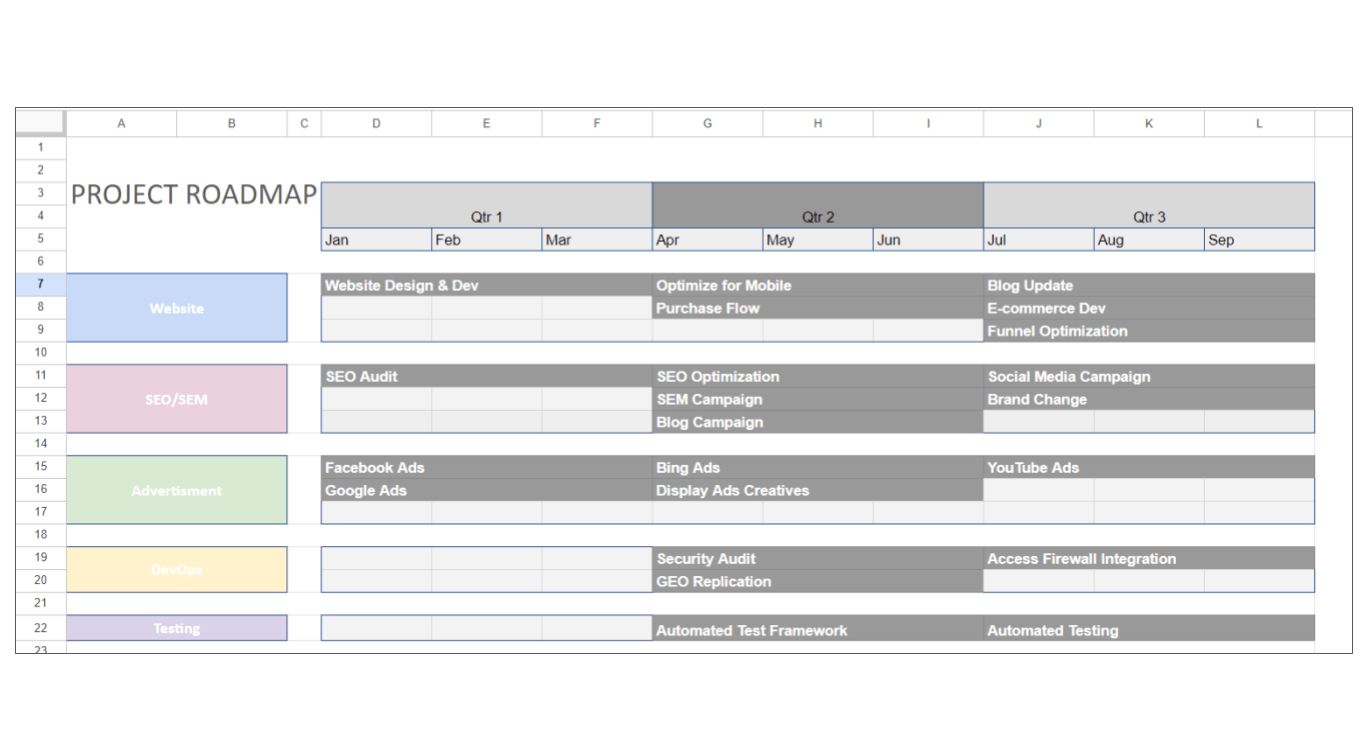
Step 1: Plan Your Roadmap
Before diving into Excel, outline your key milestones or goals and the timeline. This planning will help you structure the roadmap effectively.
Step 2: Set Up Your Spreadsheet
- Open Excel: start with a new workbook.
- Create the Timeline: in the top row, enter the timeline (e.g., months, quarters, or years). For example, if your roadmap spans a year, you might label cells B1 to M1 as January, February, ..., December.
Step 3: Add Categories
In column A, enter the names of different categories if needed. For example, you can use team member names, team types, or areas.
Step 4: Enter Milestones or Tasks
Create the milestones or tasks visualized as rectangles along the timeline.
Step 5: Customize the Roadmap
- Format Cells: use cell colors to indicate different phases or statuses. For example, you can color the cells corresponding to each task’s timeline. Add borders to separate different sections clearly.
- Add Labels: use text boxes or comments to add details about each milestone or task. To add a text box, go to the Insert tab, click on Text Box, and place it near the relevant cell.
🔔Download Roadmap in Excel Template
Why Roadmaps are Important?
Roadmaps are crucial for several reasons, each contributing to the overall success and efficiency of an initiative.

- Provides Direction and Clarity: a roadmap offers a clear path to follow, ensuring that all team members understand the long-term vision and the steps needed to get there. This clarity helps in avoiding confusion and keeps everyone aligned with the project's objectives.
- Helps in Prioritizing Tasks: by outlining the key milestones and the timeline to achieve them, a roadmap helps in prioritizing tasks. It allows teams to focus on what’s most important at any given time, ensuring that resources are allocated effectively and efficiently.
- Facilitates Communication and Alignment: roadmaps are powerful communication tools. They provide a visual representation that is easy to understand and share with stakeholders. This facilitates better communication, ensuring that everyone involved is on the same page and working towards the same goals.
- Tracks Progress and Manages Expectations: roadmaps are not static; they evolve as the project progresses. Regularly updating the roadmap helps in tracking progress and managing expectations. It provides a reference point to measure achievements against the plan and make necessary adjustments along the way.
- Enhances Motivation and Accountability: having a clear roadmap boosts motivation by providing a tangible representation of progress. It also enhances accountability, as responsibilities and timelines are clearly defined, making it easier to track who is responsible for what.
Common Questions and Misconceptions
How Does a Roadmap Differ From a Gantt Chart / a Project Plan?
A roadmap provides a high-level overview of the project’s objectives, milestones, and timeline, focusing on the "what" and "when." In contrast, a Gantt chart is a detailed, time-based representation of a project plan, showing the "how" and "who" by breaking down the project into specific tasks and timelines.
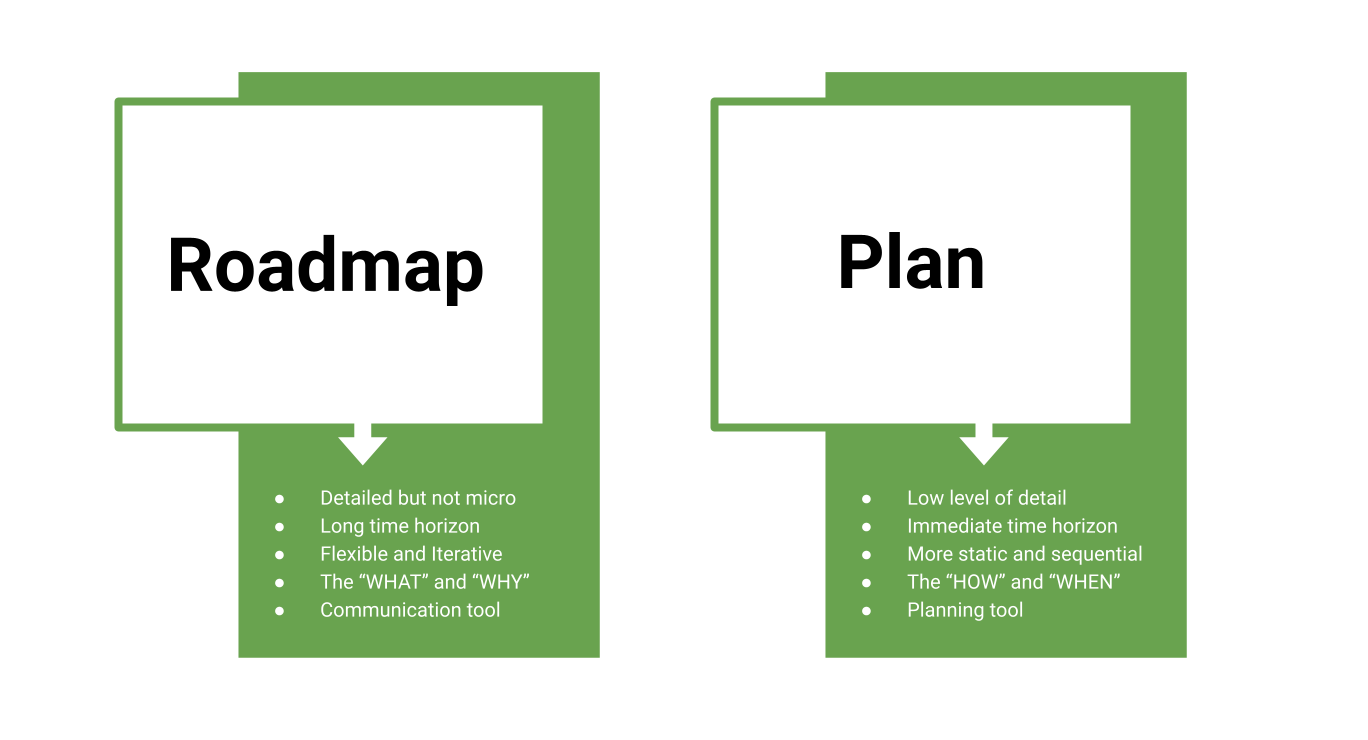
How Does a Roadmap Differ From a Burndown Chart?
A roadmap outlines the overall vision, key milestones, and timeline for a project or product, while a burndown chart tracks the remaining work against time, commonly used in agile projects to monitor progress towards completion.
What Type of Standards Collectively Provide a Roadmap for Analysts to Follow?
Standards such as ISO, Six Sigma, and industry-specific guidelines collectively provide a roadmap for analysts to follow, ensuring consistency, quality, and best practices in their work.
How Detailed Should a Roadmap Be?
The level of detail in a roadmap depends on its purpose and audience. However, a good rule of thumb is to keep it as detailed as necessary to convey the vision and key milestones without overwhelming with specifics.
Too much detail can clutter the roadmap and make it difficult to see the big picture, while too little detail can leave stakeholders confused about the direction and priorities.
How Often Should Stakeholders and Team Members Review a Project Roadmap?
Roadmaps should be living documents that are regularly reviewed and updated to reflect progress and changes in strategy. The frequency of updates can vary based on the nature of the project or product:
- Quarterly Reviews: for most projects and products, quarterly updates are ideal. This allows for adjustments based on recent developments and aligns with many business planning cycles.
- Major Milestones: update the roadmap whenever significant milestones are reached or major changes occur in the project scope or market conditions.
- Stakeholder Meetings: use regular stakeholder meetings to review and adjust the roadmap as needed.
Can a Roadmap Change, and If So, How to Manage Changes?
Yes, roadmaps can and should change in response to new information, changing market conditions, or shifts in strategic priorities. By proactively managing changes to the roadmap, you can ensure that it remains a valuable tool for guiding the project or product to success, despite any shifts in the landscape.
What is the Agile Approach to Create Project Roadmap?
An agile approach to creating a project roadmap involves iterative development and regular feedback loops. It allows for flexibility and adaptability, ensuring that the roadmap evolves based on real-time insights and changes.
What is the Purpose of the Product Roadmap in a Value Roadmap?
The purpose of a product roadmap within a value roadmap is to provide a strategic and transparent plan that aligns product development with business goals and customer value. It prioritizes features and initiatives based on their impact, facilitates collaboration across teams, and sets realistic expectations for stakeholders by clearly communicating the vision, direction, and progress of the product.
Benefits of Using a Roadmap
Roadmaps are invaluable tools that offer numerous benefits, enhancing the efficiency and effectiveness of projects, products, and strategies. Here are some key advantages:
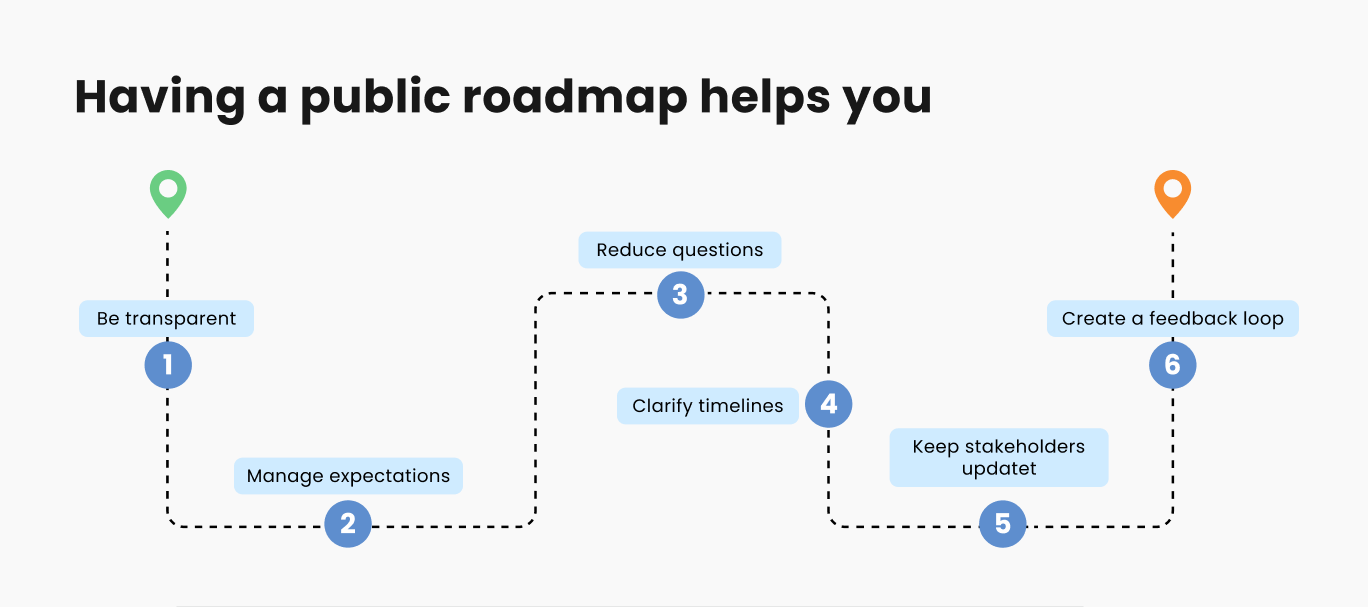
1. Improved Focus and Direction
- Clarity of Vision: a roadmap provides a clear vision of the end goals, ensuring that everyone understands the direction and purpose of the project or product.
- Prioritization: by outlining key milestones and timelines, roadmaps help in prioritizing tasks and activities, ensuring that efforts are concentrated on what’s most important.
2. Better Resource Management
- Resource Allocation: roadmaps enable better planning and allocation of resources, such as time, budget, and personnel, by clearly defining when and where resources are needed.
- Efficiency: with a roadmap, teams can avoid redundancy and inefficiencies, as it ensures that resources are used effectively to achieve the set milestones.
3. Enhanced Communication and Collaboration
- Stakeholder Alignment: roadmaps serve as a communication tool that aligns all stakeholders, providing a common understanding of goals, timelines, and responsibilities.
- Team Collaboration: by clearly outlining tasks and deadlines, roadmaps facilitate better collaboration within teams, ensuring that everyone works towards the same objectives.
Conclusion
In summary, roadmaps are indispensable strategic tools that offer a high-level visual representation of the key steps, milestones, and timelines required to achieve specific goals. Whether you're managing a project, launching a product, steering a business, or planning personal development, roadmaps provide clarity, direction, and a shared understanding among all stakeholders.
By incorporating goals and objectives, identifying milestones, setting timelines, assigning responsibilities, and adapting to changes, roadmaps ensure that everyone is aligned and focused on the same vision. They help prioritize tasks, facilitate communication, track progress, manage expectations, and enhance both motivation and accountability within teams.
About the Author
Violetta Chernobuk is a skilled content strategist and writer at Planyway, specializing in crafting insightful and engaging articles on productivity and project management. With her keen eye for detail and a deep understanding of user needs, Violetta ensures that every piece of content is both informative and inspiring, helping readers optimize their workflows and stay ahead in their projects.
